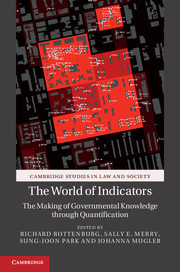Book contents
- Frontmatter
- Contents
- List of figures
- List of tables
- List of abbreviations
- List of contributors
- 1 A world of indicators: The making of governmental knowledge through quantification
- 2 The flight of the indicator
- 3 Narrating numbers
- 4 By their own account: (Quantitative) Accountability, Numerical Reflexivity and the National Prosecuting Authority in South Africa
- 5 Failure by the numbers? Settlement statistics as indicators of state performance in South African land restitution
- 6 Doing the transparent state: Open government data as performance indicators
- 7 Charting the road to eradication: Health facility data and malaria indicator generation in rural Tanzania
- 8 ‘Nobody is going to die’: An ethnography of hope, indicators and improvizations in HIV treatment programmes in Uganda
- 9 Financial indicators and the global financial crash
- 10 New global visions of microfinance: The construction of markets from indicators
- 11 Spirits of neoliberalism: ‘Competitiveness’ and ‘wellbeing’ indicators as rival orders of worth
- 12 Climate change vulnerability indicators: from noise to signal
- 13 Retroaction: how indicators feed back onto quantified actors
- Index
- Cambridge Studies in Law and Society
- References
6 - Doing the transparent state: Open government data as performance indicators
Published online by Cambridge University Press: 05 October 2015
- Frontmatter
- Contents
- List of figures
- List of tables
- List of abbreviations
- List of contributors
- 1 A world of indicators: The making of governmental knowledge through quantification
- 2 The flight of the indicator
- 3 Narrating numbers
- 4 By their own account: (Quantitative) Accountability, Numerical Reflexivity and the National Prosecuting Authority in South Africa
- 5 Failure by the numbers? Settlement statistics as indicators of state performance in South African land restitution
- 6 Doing the transparent state: Open government data as performance indicators
- 7 Charting the road to eradication: Health facility data and malaria indicator generation in rural Tanzania
- 8 ‘Nobody is going to die’: An ethnography of hope, indicators and improvizations in HIV treatment programmes in Uganda
- 9 Financial indicators and the global financial crash
- 10 New global visions of microfinance: The construction of markets from indicators
- 11 Spirits of neoliberalism: ‘Competitiveness’ and ‘wellbeing’ indicators as rival orders of worth
- 12 Climate change vulnerability indicators: from noise to signal
- 13 Retroaction: how indicators feed back onto quantified actors
- Index
- Cambridge Studies in Law and Society
- References
Summary
Data is the new raw material of the 21st century; it allows citizens to hold governments to account, drives improvements in public services by informing choice, and provides a feedstock for innovation and growth.
Google Data Analytics Social Science Research (2012)Introduction
In 2010 the Cabinet Office of the UK government introduced its Transparency Agenda (TA) as a key part of its efficiency and reform programme and as a means of taking power away from Whitehall and putting it in the hands of the public. Through the oversight of the Public Sector Transparency Board, all Whitehall departments must publish key public data-sets, from expenses to business plans, on their websites in specified open data standards as a means of advancing a public right to data. A number of platforms then consolidate all of the data via online and interactive access points. In addition to spurring service delivery improvements and stimulating the digital economy, the TA is said to be liberating and making government data more accessible, interesting and dynamic via websites, mobile device apps and other platforms. Along with powerful visualization devices, quantitative data about the performance of the state is being rendered accessible and legible in innovative ways. Through the TA government data is on the move and travelling to myriad sites and even sceptics see the possibilities that are opened up by this ‘big data’.
As the title of this chapter suggests, open government data constitute indicators of the state's performance just as indicators in general make phenomena visible so that they can be assessed, compared and ranked. The TA ostensibly renders the state visible to scrutiny such that the gaze is turned from the governed back onto the governors where subjects of ‘dataveillance’ now engage in ‘sousveillance’ – a ‘watchful vigilance from underneath’ (Dennis 2008). In a time of Wikileaks, MPs' expenses and open government data, it is tempting to conclude that ‘seeing like a state’ (Scott 1998) is being transformed into ‘seeing a state’. However, rather than considering the TA as a practice of disclosure and oversight, I argue that the transparent state is being done by a changing configuration of mediators that is generative of data publics and multiple versions of the state and the very condition that it seeks to eradicate: distrust in the workings of the state.
- Type
- Chapter
- Information
- The World of IndicatorsThe Making of Governmental Knowledge through Quantification, pp. 127 - 150Publisher: Cambridge University PressPrint publication year: 2015
References
- 20
- Cited by



